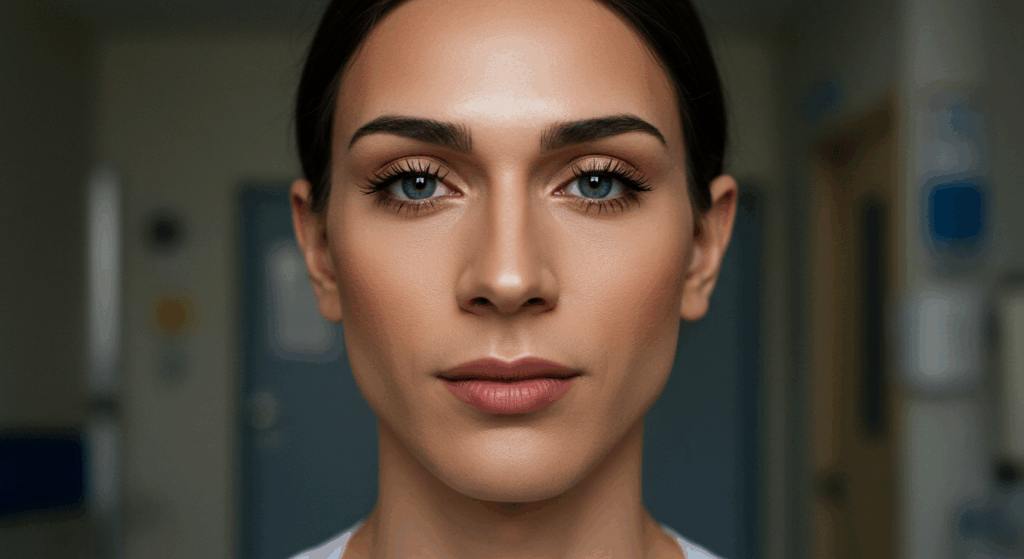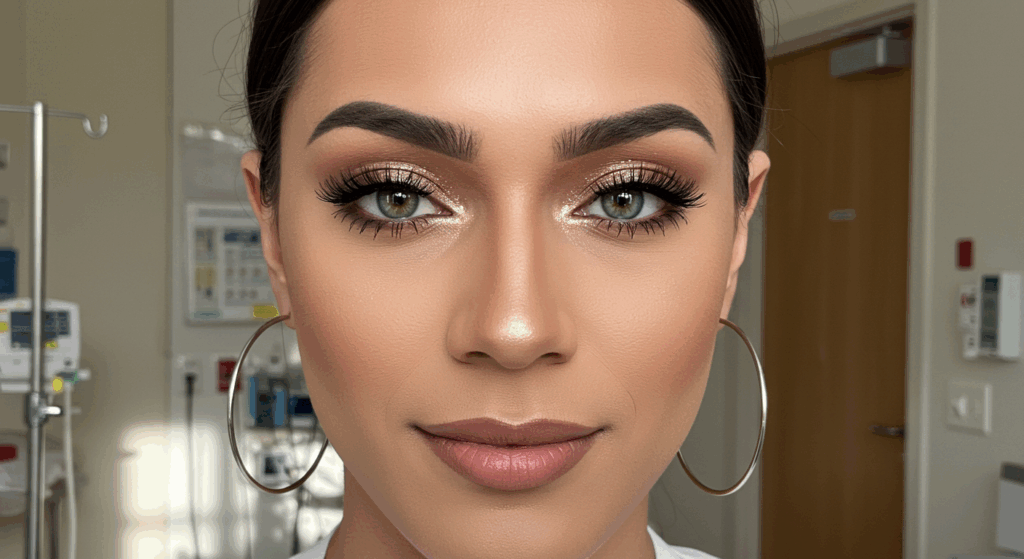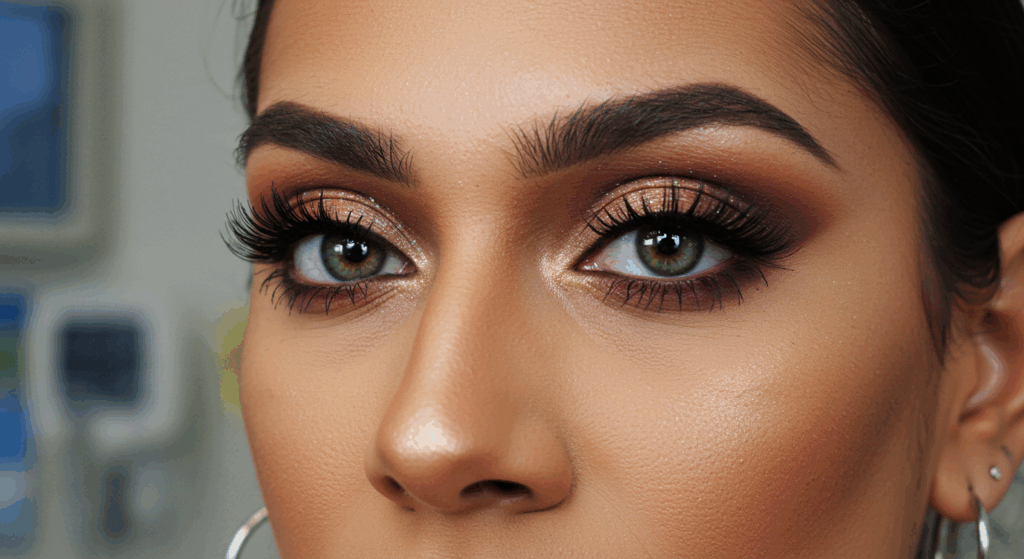For individuals seeking facial feminization surgery (FFS), the desire for a softer, more feminine appearance often extends to every feature of the face, including the eyes. The eyes are often considered the windows to the soul, and their shape, position, and surrounding structures play a pivotal role in overall facial aesthetics and gender perception. It’s natural, therefore, for patients to inquire about how FFS might influence their eye shape. However, the exact extent to which FFS can alter the fundamental shape of the eyes is a nuanced topic, often misunderstood.
This comprehensive guide will delve deep into how FFS procedures can subtly or significantly influence the appearance of the eye area, clarifying what is truly achievable and, more importantly, what the inherent limitations are. We will explore the mechanisms by which procedures like forehead contouring and brow lifts impact the periorbital region, distinguish between bone and soft tissue changes, and highlight the critical factors that determine the achievable extent of eye shape modification. Our aim is to provide you with a realistic, evidence-based understanding, empowering you to set appropriate expectations and engage in informed discussions with your surgical team.

Table of Contents
How Facial Feminization Surgery Procedures Affect Eye Appearance
While FFS doesn’t directly operate on the eyeball itself, several core procedures can indirectly or directly influence the perception and subtle shape of the eye area by altering the surrounding bony and soft tissue structures. Understanding these mechanisms is key to appreciating the transformative potential of FFS in the periorbital region.
Forehead Contouring and Brow Bone Reduction
One of the most impactful FFS procedures on the eye area is forehead contouring, particularly brow bone reduction (Type 3 cranioplasty). In many masculine facial structures, the brow ridge is prominent and projects forward, casting a shadow over the upper eyelids and making the eyes appear deeper-set or smaller. By precisely reducing this frontal bossing, surgeons can achieve several feminizing effects:
- Increased Eye Exposure: Reducing the brow ridge allows more light to fall on the eyes, making them appear larger, brighter, and more open. This often creates the illusion of more visible upper eyelids.
- Softened Orbit: A flatter, more rounded forehead transitions more smoothly into the orbital area, creating a less heavy and more delicate appearance around the eyes.
- Improved Brow Position: While not a direct brow lift, reducing the underlying bone support can sometimes allow the brow to settle into a slightly higher or more arched position, further opening the eye area.
The subtle yet profound impact of brow bone reduction on eye aesthetics cannot be overstated. It’s often the foundational step in feminizing the upper face and, by extension, enhancing the overall appearance of the eyes.
Brow Lift Techniques
Brow lifts, though sometimes considered complementary to FFS, are often integral to achieving optimal feminization of the upper face. These procedures specifically aim to raise and reshape the eyebrows, which in turn significantly alters the shape of the eye opening and addresses concerns like hooding or a perpetually tired appearance. Different techniques include:
- Coronal Brow Lift: Involves an incision behind the hairline to lift the entire forehead and brows. This can significantly open the eye area.
- Endoscopic Brow Lift: Uses small incisions and an endoscope to achieve a similar lift with less invasive techniques, resulting in less scarring.
- Hairline Brow Lift: Incision along the hairline, allowing direct lifting of the brow and often used to simultaneously address forehead height.
- Direct Brow Lift: Incision directly above the brow, used for specific, localized brow lifting.
By repositioning the eyebrows, these techniques can reduce excess skin above the eyes (hooding), reveal more of the upper eyelid, and create a more arched, feminine brow shape. This, in turn, contributes to a more open, alert, and feminized eye appearance, even without directly touching the eyelids themselves.
Orbital Rim Contouring
Beyond the brow bone, the bony structure encircling the entire eye — the orbital rim — also plays a role in eye appearance. While more subtle than brow bone reduction, contouring of the lateral (outer) and inferior (lower) orbital rims can contribute to a softer, more feminine look. For instance:
- Lateral Orbital Rim Reduction: Reducing the prominence of the outer orbital rim can make the eyes appear less deeply set and the temples less hollow.
- Inferior Orbital Rim Smoothing: In some cases, minor smoothing of the lower orbital rim can improve the transition to the cheek, indirectly influencing the appearance of the lower eyelid.
These procedures focus on very precise, millimeter-level adjustments to the bone, aiming to soften angles and create more harmonious contours around the eyes, subtly reshaping the orbital opening and enhancing the overall periorbital aesthetic.
Upper Blepharoplasty (Complementary Procedure)
Upper blepharoplasty, while not strictly an FFS procedure, is frequently performed concurrently with FFS, especially for patients who have significant excess skin or fat on their upper eyelids (often referred to as ‘hooded eyes’). This procedure directly addresses the soft tissue of the eyelid:
- Removal of Excess Skin and Fat: The surgeon meticulously removes redundant skin and, if necessary, small pockets of fat from the upper eyelid.
- Improved Eyelid Crease: This often results in a more defined eyelid crease and a more open eye appearance.
- Revealing More of the Eye: By eliminating drooping skin, blepharoplasty reveals more of the iris and sclera, making the eyes appear larger and more alert.
When combined with bony changes from FFS, upper blepharoplasty can significantly enhance the feminization of the eye area, tackling both skeletal and soft tissue contributions to the overall appearance.

Fundamental Limitations of FFS in Directly Changing Eye Shape
While the procedures discussed above can profoundly impact the *appearance* of the eyes and the surrounding structures, it’s crucial to understand the fundamental limitations of FFS in directly altering the actual shape of the eyeball itself or the deep orbital anatomy. FFS primarily focuses on bone, and there are inherent biological boundaries to what can be achieved.
Fixed Position and Size of the Eyeball
Perhaps the most critical limitation is that FFS cannot change the eyeball itself. The size, shape, and inherent position of your eyeball within the socket are genetically determined and fixed. FFS procedures do not manipulate the ocular globe. Therefore, expectations that FFS can make your actual eyeballs larger or smaller, or change their fundamental spherical shape, are unrealistic.
Unalterable Deep Orbital Anatomy
The eye socket (orbit) is a complex bony structure that houses and protects the eyeball. While FFS can contour the outer edges (orbital rims) and the brow bone, the deep, fundamental structure and depth of the eye socket are largely beyond the scope of FFS. Surgeons can’t significantly expand or shrink the entire orbital cavity, nor can they drastically reposition the eyeball within it. The integrity of the orbit is crucial for eye function and protection, and radical alterations would carry significant risks to vision and ocular health.
Primary Focus on Bony Structures in FFS
FFS, by its very definition, is “facial feminization surgery,” implying a significant focus on modifying the skeletal framework of the face. While soft tissue can be repositioned or tightened over these altered bones, FFS does not primarily target soft tissues like the eyelids, tear ducts, conjunctiva, or the muscles that control eye movement. Procedures that directly address these soft tissues, like certain types of blepharoplasty or canthoplasty, are distinct from the core bony FFS procedures and have their own specific indications and limitations.
Limits of Soft Tissue Repositioning for Eye Shape
While a brow lift can reposition the brow and surrounding soft tissue to open the eye area, and blepharoplasty can remove excess eyelid skin, these procedures do not fundamentally change the *shape* of the eye opening itself in a dramatic way. They primarily address laxity, hooding, or the position of the brow relative to the eye. For instance, if someone desires a significantly different eye “slant” or a complete change in the almond shape of their eye, soft tissue repositioning alone, or in conjunction with FFS, has significant limits. The inherent elasticity and amount of available soft tissue dictate the degree of change possible.
Genetic and Ethnic Predispositions
Fundamental eye characteristics, such as the presence of epicanthal folds, the thickness of eyelid skin, the natural set of the eyes (prominent or deep-set), and the overall shape of the palpebral fissure (the opening between the eyelids), are largely determined by genetics and ethnic background. While FFS can make significant improvements to the surrounding bone structure and soft tissue drape, it cannot override these deep-seated genetic predispositions to fundamentally change the inherent characteristics of your eyes. For example, FFS cannot transform a naturally rounded eye into a significantly more almond-shaped eye if the underlying anatomy doesn’t permit it.

Key Factors Determining the Achievable Extent of Eye Shape Change
Given the inherent limitations, what then determines how much the *appearance* of the eyes can actually be feminized and refined through FFS and complementary procedures? Several critical factors come into play, influencing the scope and success of periorbital aesthetic changes.
Original Orbital Bone Structure and Depth
The pre-existing dimensions and contours of your orbital bones are the primary determinant of your starting point and the ultimate potential for change. Individuals with a very prominent brow ridge or deeply set eyes due to their inherent bone structure will likely experience more noticeable ‘opening’ of the eye area from brow bone reduction. Conversely, those with a naturally softer brow and less projection may see more subtle changes from bone work alone. The depth of the orbital socket also dictates how much the eye can appear to ‘come forward’ or ‘recede’ based on surrounding bone work.
Natural Eye Prominence or Recession
Whether your eyes are naturally more prominent (exophthalmos) or recessed (enophthalmos) significantly influences surgical outcomes. For prominent eyes, feminizing the surrounding bone can create a more balanced look. For recessed eyes, reducing a heavy brow can help bring the eyes ‘forward’ visually. Extreme cases of prominence or recession may require specialized orbital surgery beyond the scope of typical FFS to achieve significant changes, and even then, such changes are complex and carry higher risks.
Skin Quality and Eyelid Laxity
The quality, elasticity, and thickness of the skin around your eyes, particularly the eyelids, play a crucial role. Patients with significant eyelid laxity (loose skin) or excess fat pockets will benefit more from complementary procedures like blepharoplasty. Good skin elasticity allows for better redraping of tissues after bony alterations, contributing to a smoother, more natural-looking result. Poor skin quality or significant sun damage might limit the optimal outcome of soft tissue tightening.
Importance of a Highly Experienced FFS Surgeon
The periorbital area is incredibly delicate and complex. Achieving subtle, effective, and natural-looking feminization around the eyes requires exceptional surgical skill, an intricate understanding of facial anatomy, and an artistic eye. A highly experienced FFS surgeon will know precisely how much bone to remove or reshape, how to perform brow lifts to achieve a natural arch, and when to recommend complementary soft tissue procedures. Their expertise in blending these techniques is paramount to a harmonious overall result.
Customized Surgical Plan and Approach
There is no one-size-fits-all approach to FFS, especially concerning the eyes. A skilled surgeon will conduct a thorough pre-operative analysis, often using 3D imaging, to assess your unique anatomy and discuss your specific goals. They will then tailor a surgical plan that optimally combines procedures (e.g., forehead contouring, brow lift, blepharoplasty) to achieve the best possible enhancement of your periorbital aesthetics within realistic boundaries. This individualized approach is critical for maximizing positive outcomes.
Understanding Surgical Boundaries
It is vital for patients to have a clear, realistic understanding of what FFS can and cannot do for eye shape. Surgeons should educate patients thoroughly about the distinction between altering the *appearance* of the eye area (by changing surrounding bone and soft tissue) and fundamentally changing the *eyeball* or deep orbital structure. Unrealistic expectations can lead to dissatisfaction, even when a technically excellent surgical result has been achieved.
Communication with the Surgical Team
Open and honest communication with your surgical team before surgery is indispensable. Share your aesthetic goals for your eyes clearly, and listen attentively to your surgeon’s assessment of what is achievable. Ask questions, seek clarification, and ensure that your expectations align with what the surgeon can realistically deliver. This collaborative approach ensures that both you and your surgical team are working towards the same, achievable vision.

Optimizing Periorbital Aesthetics Within FFS Boundaries
Given the nuanced nature of eye shape changes in FFS, the most effective approach is to focus on optimizing the overall periorbital aesthetics within the inherent surgical boundaries. This involves comprehensive planning and integrating various strategies to achieve the most harmonious and feminized eye area possible.
Integrating Eye Area Considerations into Overall FFS Strategy
The eyes do not exist in isolation; they are integral to the entire face. For optimal feminization, changes to the eye area must be planned in harmony with other FFS goals, such as jawline reduction, chin reshaping, or rhinoplasty. A holistic approach ensures that the feminized eyes complement and enhance the feminized nose, forehead, and lower face, creating a cohesive and naturally feminine appearance. The goal is not just to change the eyes but to make them fit beautifully within a newly feminized facial frame.
Comprehensive Pre-Surgical Imaging and Analysis
Advanced imaging technologies, such as 3D CT scans and photographic morphing tools, are invaluable in the planning phase. These tools allow surgeons to precisely analyze your existing bone structure, identify areas for reduction or augmentation, and even simulate potential post-surgical results. Patients can use these tools to visualize how forehead contouring or a brow lift might alter their eye appearance, fostering a clearer understanding of potential outcomes and aiding in shared decision-making.
Complementary Procedures for Soft Tissue Refinement
While FFS primarily targets bone, achieving comprehensive periorbital feminization often necessitates complementary procedures that address soft tissues. These are usually performed by the FFS surgeon or sometimes in collaboration with an oculoplastic surgeon:
- Upper and Lower Blepharoplasty: As discussed, these procedures remove excess skin and fat from the eyelids, significantly opening the eyes and reducing signs of aging or heaviness.
- Canthoplasty (Lateral Canthopexy/Canthoplasty): These procedures can subtly alter the outer corner of the eye (lateral canthus) to adjust its position or tighten the lower eyelid. This can be used to slightly raise a downward-sloping canthus or to address lower eyelid laxity, which can indirectly contribute to a more feminized or alert eye shape.
- Fat Grafting or Fillers: Strategic placement of fat grafts or dermal fillers around the eyes can address hollowness in the tear troughs or temples, adding volume and smoothing contours, which can rejuvenate and soften the eye area.
These soft tissue procedures, when integrated thoughtfully with bony FFS, can significantly enhance the overall outcome around the eyes, providing a more refined and youthful appearance.
Non-Surgical Aesthetic Considerations
Beyond surgery, patients can further optimize their periorbital aesthetics through non-surgical means once healing is complete. These can include:
- Makeup: Strategic application of eyeliner, eyeshadow, and mascara can create illusions of different eye shapes, sizes, and depths, enhancing the feminized surgical results.
- Brow Styling: Professional eyebrow shaping, waxing, threading, or microblading can refine the arch and thickness of the brows, further framing the eyes in a feminine way and complementing the brow lift results.
- Skincare: Consistent use of appropriate skincare products can maintain skin quality around the eyes, reducing puffiness or dark circles and contributing to a brighter, more refreshed look.
These non-surgical methods empower individuals to fine-tune their appearance and maximize the aesthetic benefits achieved through surgery.

Conclusion
The journey of facial feminization surgery offers profound transformations, and the eye area is undoubtedly a critical component of achieving a harmonized, feminine aesthetic. While FFS procedures like forehead contouring, brow lifts, and orbital rim contouring can dramatically impact the *appearance* of the eyes by altering the surrounding bony framework and soft tissue drape, it is crucial to recognize their fundamental limitations. FFS cannot change the size or position of the eyeball itself, nor can it override deep genetic predispositions that determine inherent eye shape.
The achievable extent of eye shape change is a complex interplay of your original anatomy, the skill of your surgeon, and realistic expectations. By understanding these nuances, engaging in open communication with your surgical team, and embracing a holistic approach that may include complementary soft tissue procedures and non-surgical refinements, you can optimize your periorbital aesthetics and achieve a truly feminized and beautiful outcome.
Key Takeaways
- FFS procedures (forehead contouring, brow lifts, orbital rim contouring) primarily affect the *appearance* of the eyes by altering surrounding bone and soft tissue, making them appear larger, more open, or more defined.
- FFS cannot change the fundamental size, shape, or position of the eyeball itself, nor can it drastically alter deep orbital anatomy or override genetic eye characteristics.
- Achievable eye changes depend heavily on original bone structure, skin quality, and the highly specialized expertise of your FFS surgeon.
- Optimal periorbital feminization often involves integrating FFS with complementary procedures like blepharoplasty and may be enhanced by non-surgical aesthetic considerations.
- Realistic expectations and clear communication with your surgical team are paramount for satisfaction with your results.
FAQ
Can FFS change my eye color or the actual size of my eyeballs?
No, FFS cannot change your eye color or the actual size of your eyeballs. Your eye color is determined by the amount of melanin in the iris, and the size of your eyeballs is genetically fixed. FFS procedures focus on altering the bony and soft tissue structures surrounding the eyes, not the eyes themselves.
How much can FFS alter the “slant” or “tilt” of my eyes?
FFS procedures, particularly brow lifts and subtle lateral canthoplasty (a complementary procedure), can influence the “slant” or “tilt” of the eyes, but usually to a subtle degree. For instance, a brow lift can elevate the tail of the brow, which can give the *illusion* of a slight upward tilt to the outer corner of the eye. Lateral canthoplasty can also make very minor adjustments to the outer corner. However, dramatic changes to the inherent slant of the eye are generally not achievable or advisable with FFS and related procedures due to anatomical limitations and potential risks to eye function.
Is it possible to completely eliminate epicanthal folds with FFS?
FFS primarily targets bone and some overlying soft tissue. While certain soft tissue procedures (like epicanthoplasty) exist to reduce epicanthal folds (the skin fold of the upper eyelid covering the inner corner of the eye), they are not core FFS procedures and carry their own risks and considerations. FFS alone, through changes to the brow bone, may subtly reduce the *prominence* of the fold in some individuals by opening the eye area, but it cannot guarantee complete elimination, especially if the folds are a significant genetic characteristic.
What are realistic expectations for eye shape changes from forehead feminization?
Realistic expectations for eye shape changes from forehead feminization (brow bone reduction) include a more open and brighter eye appearance, with the eyes appearing larger due to the removal of shadowing from a prominent brow ridge. You can expect a softening of the upper orbital rim, which can make the eyes look less deep-set and more exposed. It does not change the actual shape of your eyeball but rather the perception of its size and the surrounding frame.
Are there non-surgical options to further feminize the eye area after FFS?
Yes, absolutely. After FFS, non-surgical options can further enhance and feminize the eye area. These include:
- Dermal Fillers: To address tear trough hollows or volume loss around the temples.
- Botox/Dysport: To soften wrinkles around the eyes (crow’s feet) or fine-tune brow position.
- Professional Brow Styling: Shaping, waxing, threading, or microblading can refine your eyebrow arch and thickness to complement your new facial contours.
- Strategic Makeup: Using makeup techniques (e.g., eyeliner, eyeshadow, mascara) to create illusions of desired eye shape or size.
These options can refine and optimize the aesthetic outcome achieved through surgery.
Visit Dr.MFO Instagram profile to see real patient transformations! Get a glimpse of the incredible results achieved through facial feminization surgery and other procedures. The profile showcases before-and-after photos that highlight Dr. MFO’s expertise and artistic vision in creating natural-looking, beautiful outcomes.
Ready to take the next step in your journey? Schedule a free consultation with Dr. MFO ( Best Facial Feminization Surgeon for You) today. During the consultation, you can discuss your goals, ask any questions you may have, and learn more about how Dr. MFO can help you achieve your desired look. Don’t hesitate to take advantage of this free opportunity to explore your options and see if Dr. MFO is the right fit for you.










